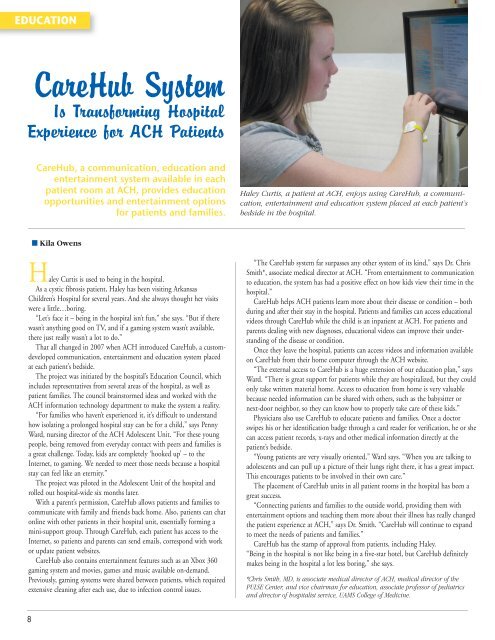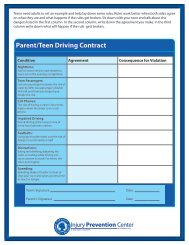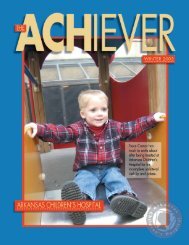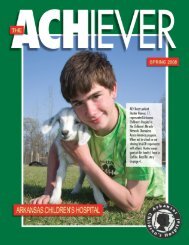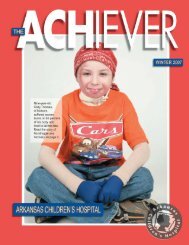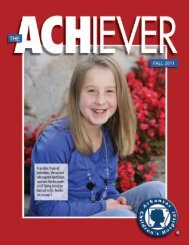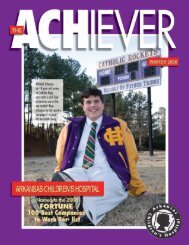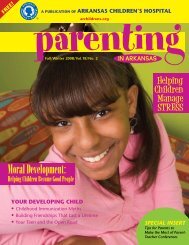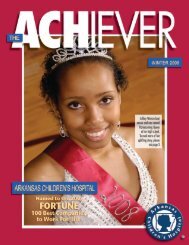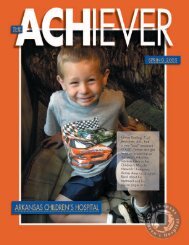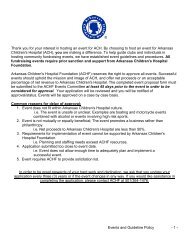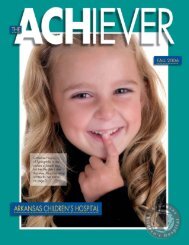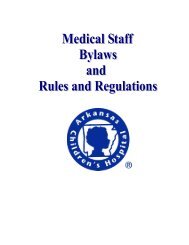Spring 2010 - Arkansas Children's Hospital
Spring 2010 - Arkansas Children's Hospital
Spring 2010 - Arkansas Children's Hospital
Create successful ePaper yourself
Turn your PDF publications into a flip-book with our unique Google optimized e-Paper software.
EDUCATION<br />
CareHub System<br />
Is Transforming <strong>Hospital</strong><br />
Experience for ACH Patients<br />
CareHub, a communication, education and<br />
entertainment system available in each<br />
patient room at ACH, provides education<br />
opportunities and entertainment options<br />
for patients and families.<br />
Haley Curtis, a patient at ACH, enjoys using CareHub, a communication,<br />
entertainment and education system placed at each patient’s<br />
bedside in the hospital.<br />
■ Kila Owens<br />
Haley Curtis is used to being in the hospital.<br />
As a cystic fibrosis patient, Haley has been visiting <strong>Arkansas</strong><br />
Children’s <strong>Hospital</strong> for several years. And she always thought her visits<br />
were a little…boring.<br />
“Let’s face it – being in the hospital isn’t fun,” she says. “But if there<br />
wasn’t anything good on TV, and if a gaming system wasn’t available,<br />
there just really wasn’t a lot to do.”<br />
That all changed in 2007 when ACH introduced CareHub, a customdeveloped<br />
communication, entertainment and education system placed<br />
at each patient’s bedside.<br />
The project was initiated by the hospital’s Education Council, which<br />
includes representatives from several areas of the hospital, as well as<br />
patient families. The council brainstormed ideas and worked with the<br />
ACH information technology department to make the system a reality.<br />
“For families who haven’t experienced it, it’s difficult to understand<br />
how isolating a prolonged hospital stay can be for a child,” says Penny<br />
Ward, nursing director of the ACH Adolescent Unit. “For these young<br />
people, being removed from everyday contact with peers and families is<br />
a great challenge. Today, kids are completely ‘hooked up’ – to the<br />
Internet, to gaming. We needed to meet those needs because a hospital<br />
stay can feel like an eternity.”<br />
The project was piloted in the Adolescent Unit of the hospital and<br />
rolled out hospital-wide six months later.<br />
With a parent’s permission, CareHub allows patients and families to<br />
communicate with family and friends back home. Also, patients can chat<br />
online with other patients in their hospital unit, essentially forming a<br />
mini-support group. Through CareHub, each patient has access to the<br />
Internet, so patients and parents can send emails, correspond with work<br />
or update patient websites.<br />
CareHub also contains entertainment features such as an Xbox 360<br />
gaming system and movies, games and music available on-demand.<br />
Previously, gaming systems were shared between patients, which required<br />
extensive cleaning after each use, due to infection control issues.<br />
“The CareHub system far surpasses any other system of its kind,” says Dr. Chris<br />
Smith*, associate medical director at ACH. “From entertainment to communication<br />
to education, the system has had a positive effect on how kids view their time in the<br />
hospital.”<br />
CareHub helps ACH patients learn more about their disease or condition – both<br />
during and after their stay in the hospital. Patients and families can access educational<br />
videos through CareHub while the child is an inpatient at ACH. For patients and<br />
parents dealing with new diagnoses, educational videos can improve their understanding<br />
of the disease or condition.<br />
Once they leave the hospital, patients can access videos and information available<br />
on CareHub from their home computer through the ACH website.<br />
“The external access to CareHub is a huge extension of our education plan,” says<br />
Ward. “There is great support for patients while they are hospitalized, but they could<br />
only take written material home. Access to education from home is very valuable<br />
because needed information can be shared with others, such as the babysitter or<br />
next-door neighbor, so they can know how to properly take care of these kids.”<br />
Physicians also use CareHub to educate patients and families. Once a doctor<br />
swipes his or her identification badge through a card reader for verification, he or she<br />
can access patient records, x-rays and other medical information directly at the<br />
patient’s bedside.<br />
“Young patients are very visually oriented,” Ward says. “When you are talking to<br />
adolescents and can pull up a picture of their lungs right there, it has a great impact.<br />
This encourages patients to be involved in their own care.”<br />
The placement of CareHub units in all patient rooms in the hospital has been a<br />
great success.<br />
“Connecting patients and families to the outside world, providing them with<br />
entertainment options and teaching them more about their illness has really changed<br />
the patient experience at ACH,” says Dr. Smith. “CareHub will continue to expand<br />
to meet the needs of patients and families.”<br />
CareHub has the stamp of approval from patients, including Haley.<br />
“Being in the hospital is not like being in a five-star hotel, but CareHub definitely<br />
makes being in the hospital a lot less boring,” she says.<br />
*Chris Smith, MD, is associate medical director of ACH, medical director of the<br />
PULSE Center, and vice chairman for education, associate professor of pediatrics<br />
and director of hospitalist service, UAMS College of Medicine.<br />
8


